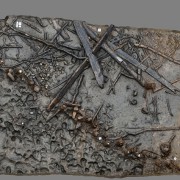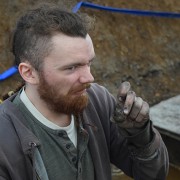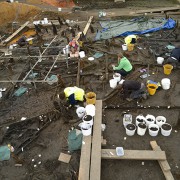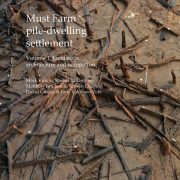Post-Ex Diary 4: 2017 – Interim Analysis
July 2, 2018
We’ve been extremely quiet over the last year about the ongoing work on the Must Farm project but that doesn’t mean that work hasn’t continued. The team has been exceptionally busy carrying out a wide variety of different tasks necessary to plan and prepare for the post-excavation programme to begin in earnest.
Much of this has been essential groundwork creating spreadsheets, examining data and processing material ready for more detailed forms of analyses to be carried out. None of these tasks are quite as exciting or dynamic as the excavation, but they are all crucial to building a detailed foundation that will form the basis of work for years to come. Owing to the large amount of material discovered during the excavation this has understandably taken time, but a lot of interesting information is already beginning to emerge.
One of the key goals of work on the project during 2017 was the creation of an assessment report, a document designed to evaluate and draw together the data gathered over the course of the dig. For this report it was decided to focus on a defined area of the site. Doing so would enable the team to get a more fine-grained understanding of an element of the settlement rather than a widespread, less detailed picture of the site. Equally, a more thorough initial exploration of a selected area would provide a dataset that could be used as a comparison going forward, allowing for potential similarities and differences to be identified.
The area chosen to concentrate on for the interim assessment was Structure One, one of the largest buildings uncovered during the excavation. It was our best-preserved structure and examining its material, the distribution of artefacts and other factors would help to directly inform the rest of the post-excavation process.
We’ve already discussed several aspects of our structures, the site and its finds in our Diary entries during the dig. Even though the physical excavation has ended, the analysis of material and data still feels very similar to being on-site as the whole team are constantly making new discoveries and uncovering fresh questions to ask. While this assessment and examination lacks the immediacy of a dig it is still an active and continually evolving component of an archaeological project. Indeed, the work is moving us closer towards a greater understanding of the Must Farm site and its occupancy.
2018: Ongoing Work and Updates

A selection of socketed axes from the site. We’ll be exploring our metalwork in more detail later this year.
Now that interim analyses have been completed and detailed plans drawn up for the post-excavation of the project, our blog entries will be returning on a regular basis. We’ll be covering a range of topics beginning with some of the details that have emerged over the previous year including the distribution and “intensity” of materials. Alongside these updates will be discussions and entries detailing the current post-excavation work, its character and how particular specialist work will contribute to enhancing our knowledge of the settlement.
Over the previous year a huge amount of preparatory work has taken place, paving the way for an exceedingly wide range of investigative techniques and methods of analysis to be employed across a variety of material. There are currently over 80 different specialists involved in the Must Farm project carrying out work ranging from the use-wear on artefacts, various residue analysis, environmental investigations and many, many others.
We can’t wait to continue our blog series and start updating you on the latest findings and progress with the project. From everyone here at the Must Farm team, we look forward to keeping in touch.
Related stories
Post Ex-Diary 22: Working Towards Publication
May 11, 2020
Post Ex-Diary 21: The Importance of Visualisation – Photography Part Two
February 17, 2020
Post-Ex Diary 19: The Importance of Visualisation – Illustration
December 9, 2019
Post-Ex Diary 18: The Importance of Visualisation – Photogrammetry
November 11, 2019
Post-Ex Diary 17: Stable Isotope Analyses and Must Farm
October 7, 2019
Post Ex-Diary 16: Parasites and Lifestyles at Must Farm
September 3, 2019
Post Ex-Diary 15: Exploring Structure 4 Part Two
August 5, 2019
Post Ex-Diary 14: Exploring Structure 4 Part One
July 15, 2019
Post-Ex Diary 13: The Must Farm Pile-Dwelling Settlement Open Access Antiquity Article
June 12, 2019
Post-Ex Diary 11: The Must Farm Textiles Part One
April 1, 2019
Post-Ex Diary 10: Specialist Analyses Part Three
March 4, 2019
Post-Ex Diary 9: Specialist Analyses Part Two
February 4, 2019
Post-Ex Diary 8: Specialist Analyses Part One
January 7, 2019
Post-Ex Diary 7: The Must Farm Pottery Refit
November 5, 2018
Learn more
About
The Must Farm pile-dwelling settlement was excavated by the Cambridge Archaeological Unit with funding from Historic England and Forterra.Publications
Read the Open Access publications the Must Farm pile-dwelling settlement: Volume 1. Landscape, architecture and occupation and Volume 2. Specialist reports.Dig Diaries
The excavation of the Must Farm settlement was carried out between August 2015 and August 2016. Take a look at our diary entries documenting the excavation process. ...read more
Discoveries
See some of the discoveries from the Must Farm pile-dwelling settlement.
Making Must Farm
Find out about our work with AncientCraft recreating Must Farm’s material.
FAQs
Further information on the Must Farm project.



























